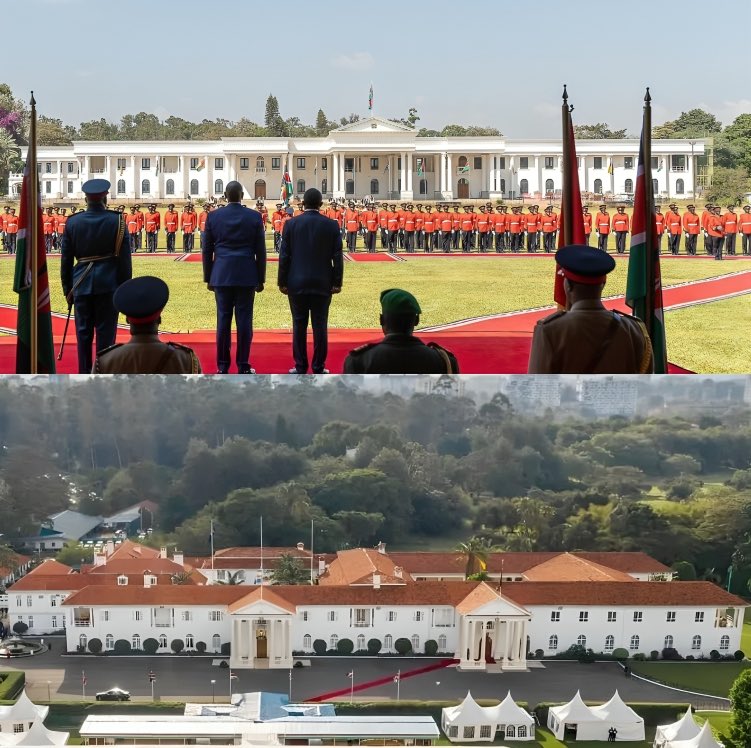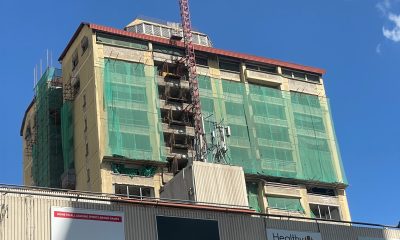News
Ruto’s State House Gets A Facelift And Kenyans Are Unimpressed
“Sir Herbert Baker’s masterpiece (Government House), now State House, has been violated. Gone is a heritage, an insult to history, and it makes no sense. We gave grabbed our national heritage and violated it. I never thought we could go this low. I am sad.” John Kamau, veteran journalist and historian remarked.

President William Ruto’s recent renovations at State House Nairobi has sparked harsh criticism among Kenyans.
The transformation of the historic colonial-era structure for state functions has been a topic of discussion online.
This was after the President’s communication team shared photos of the State reception of Umaro Sissoco Embalo, the visiting Guinea-Bissau President on January 25, hawk-eyed Kenyans quickly noticed the new-look State House.
Evidently, the new look – in the place of the tiled colonial roofing, the House on the Hill now sports a spectacular white flat roof.
Background history of Nairobi State House
The State House in Nairobi, originally known as the Government House, was constructed in 1907 by English architect Sir Herbert Baker. Designed in the Palladian style, it featured neoclassical elements like white columned loggias, reflecting European architectural traditions rather than local influences. Located on a hill near the Arboretum, it served as the governor’s residence during British colonial rule and became a symbol of authority and order. Today, it functions as Kenya’s presidential residence and administrative hub.
Sir Herbert Baker (1862–1946) was a prominent British architect known for monumental works across the British Empire. He designed notable buildings such as South Africa’s Union Buildings, New Delhi’s Secretariat Buildings (with Edwin Lutyens), and Kenya’s State House. His work often blended classical styles with imperial grandeur.
Renovations
The renovations, which reportedly includes constructing a special field for evangelism and hosting religious leaders, have been met with mixed sentiments. According to reports from Kenyan media, the cost of these renovations has been a significant point of contention.
Initially, a budget estimate showed that Ksh.11.5 billion of the taxpayers’ revenue would be spent on 13 projects including renovation of State Houses and State Lodges situated at different locations across the country.
The estimates included the refurbishment of buildings at State House, Nairobi, estimated at Ksh.1.7 billion over the next three years, with a proposed allocation of Ksh.250 million in the 2024/2025 budget estimates.
Many have voiced their disapproval, questioning the timing and cost of such expenditures. Critics argue that the money could have been better spent on critical sectors like health, education, ans kenya goes through tough economic hardships.
Most have castigated it, calling it an ugly upgrade with some going as far as stating that historical buildings should he exempt from such refurbishments.
“Sir Herbert Baker’s masterpiece (Government House), now State House, has been violated. Gone is a heritage, an insult to history, and it makes no sense. We gave grabbed our national heritage and violated it. I never thought we could go this low. I am sad.” John Kamau, veteran journalist and historian remarked.
“Refurbishments that alter the historic or architectural integrity of a monumental site like State House should be protected by the Monuments Act. State House is not private property to be remodelled to suit the fleeting tastes of each tenant.” Said Ferdinand Omondi, former BBC correspondent.
“This National Heritage deserved preservation with only necessary repairs/maintenance for generations to come.There’re enough grounds for construction of this new monstrosity. No Public views sought regarding their Monument;this ATTITUDE towards Public Assets!” Lawyer Paul Muite added his voice.
“Ruto is impressed by London Old Monuments but when he comes back home he destroys our own monuments,” another X user said.
The renovations also come at a time when President Ruto has been engaging with regional leaders, suggesting that the upgrades might also serve diplomatic purposes. However, this has not quelled the debate over whether the renovations are a priority at this juncture.
Religious leaders have added another layer to the conversation. The construction of an evangelism field at State House has led to discussions about the separation of church and state, especially after some churches rejected monetary donations from the President.
As the debate continues, it’s clear that the renovations at State House under President Ruto’s administration have become more than just an issue of aesthetics or functionality; they’ve turned into a broader discourse on governance, priorities, and public expenditure in Kenya.
This development is likely to remain a hot topic as Kenyans continue to navigate the economic and social challenges facing the country, with many keeping a close eye on how these changes at State House align with the broader national agenda.
Kenya Insights allows guest blogging, if you want to be published on Kenya’s most authoritative and accurate blog, have an expose, news TIPS, story angles, human interest stories, drop us an email on [email protected] or via Telegram
-

 News1 week ago
News1 week agoKenyan Driver Hospitalized After Dubai Assault for Rejecting Gay Advances, Passport Seized as Authorities Remain Silent
-

 Investigations3 days ago
Investigations3 days agoMoney Bior, Lawyer Stephen Ndeda Among 18 Accused Of Running An International Fraud Ring Involved With Scamming American Investor Sh500 Million
-

 Business1 week ago
Business1 week agoConstruction Of Stalled Yaya Center Block Resumes After More Than 3 Decades and The Concrete Story Behind It
-

 Investigations2 days ago
Investigations2 days agoNestlé Accused of Risking Babies’ Health in Africa with ‘Toxic’ Cerelac Product Sold Highest in Kenya
-

 Investigations2 weeks ago
Investigations2 weeks agoCNN Reveals Massive Killings, Secret Graves In Tanzania and Coverup By the Govt
-

 Investigations1 week ago
Investigations1 week agoHow Somali Money From Minnesota Fraud Ended In Funding Nairobi Real Estate Boom, Al Shabaab Attracting Trump’s Wrath
-

 News5 days ago
News5 days agoTSC Announces Major Policy Shift To End Transfer Of Promoted Teachers
-

 Politics2 weeks ago
Politics2 weeks agoI Had Warned Raila Of Possible Fallout In The Odinga Family After His Death, Oburu Says




























